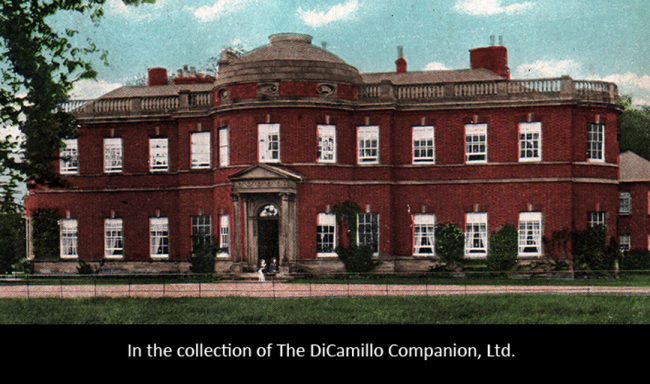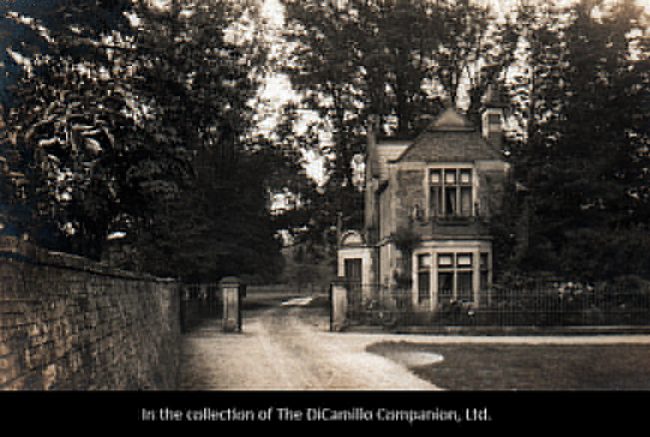
The House from a 1907 postcard

The Lodge from a 1905 postcard
Earlier Houses: There were probably several houses on the site of the 1758-83 house. The last of these, described as a "substantial mansion," was inherited in 1622 by Sir Simon Every, 1st Bt. It was this house that burned down in 1736 and was replaced by the house that is the focus of this record.
Built / Designed For: Sir John Every
House & Family History: The manor of Egginton was in existence by the time of the "Domesday Book" and included three ancient manors as part of the Egginton Estate: Hardwick Manor, Hargate Manor, and Seymour's Place Manor. The 18th century Egginton Hall of the Wyatts was a fascinating house, particularly notable for the dome on its 11-bay, two-story Entrance Façade. The dome was carried on a three-bay section that dramatically broke forward, containing the Neoclassical Composite portico on the ground floor and the intriguing three oculi in the drum of the dome. Inside, the top-lit dome housed the flying cantilevered Hoptonwood stone staircase, complete with Neoclassical wrought iron railing. There were a number of good fireplaces inside that were reused from the earlier house that burned in 1736; however, the finest fire surround was one that was made in the 1780s for the new house: a white marble fireplace with Blue John insets that was carved by George Moneypenny. The Every family, who had been seated here since the 17th century, experienced declining fortunes in the 20th century, which caused them to let the House for most of the early part of the century. After World War II the family abandoned Egginton Hall altogether and, in 1955, Sir John Every demolished the House. Bits and pieces of Egginton were removed from the House before its demolition (many pieces, including paneling, were installed in The Wilderness in West Hallam, Derbyshire). Like many British houses, Egginton Hall was supposedly haunted; in this case, by a one-armed man who walked from the churchyard to the House every midnight.
Garden & Outbuildings: It appears likely that there was a medieval moat in the Park that was filled in during the 17th century. The 50-acre Park was landscaped circa 1700 by the Derby landscape architect Lawrence Squibb. In 1736 the Egginton Estate spanned 3,200 acres and included most of the village of Newton Solney. The Park once contained an orangery, an arbor, and a temple, all 18th century and all demolished. There was also an ice house and pair of Wyatt-designed lodges -- all also gone. The Service Wing and the U-shaped Stableblock were both reused from the earlier houses (they were both demolished in the 1950s). By the time of the demolition of the House in 1955 the Estate stood at just over 2,000 acres, most of which was sold to tenants.
Architect: William Baker
Date: 1756Architect: William Wyatt
Date: 1758-61Architect: Benjamin Wyatt
Date: 1758-61Architect: Samuel Wyatt
Date: 1782-83
Title: Destruction of the Country House, The
Author: Strong, Roy; Binney, Marcus; Harris, John
Year Published: 1974
Publisher: London: Thames & Hudson Ltd.
ISBN: 0500270052X
Book Type: Softback
Title: Biographical Dictionary of British Architects, 1600-1840, A - SOFTBACK
Author: Colvin, Howard
Year Published: 1995
Publisher: New Haven: Yale University Press
ISBN: 0300072074
Book Type: Softback
House Listed: Demolished
Park Listed: Not Listed
Past Seat / Home of: SEATED AT EARLIER HOUSES: Walkelin family, 12th century. Sir William de Stafford, 13th century. Tinmore family, 14th century. Lathbury family, 14th century. Leigh famiy, 15th century. Sir Simon Every, 1st Bt., 17th century. SEATED AT 18TH CENTURY HOUSE: Sir John Every, Bt., 18th century; Every family here until 1955, but they let the House frequently during the 20th century, including to: Captain Dugdale, circa 1908. Major Frederick Gretton, 1920s.
Current Ownership Type: Demolished
Primary Current Ownership Use: Demolished
House Open to Public: No
Historic Houses Member: No